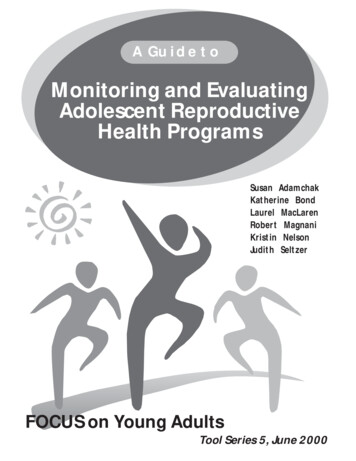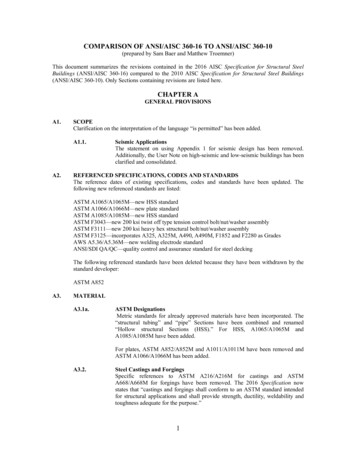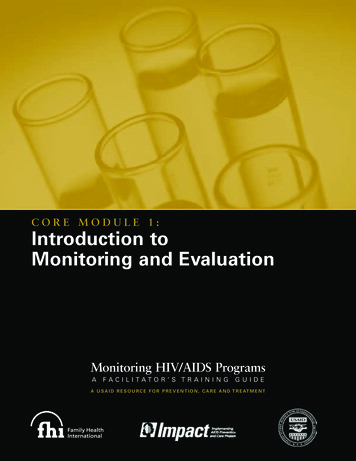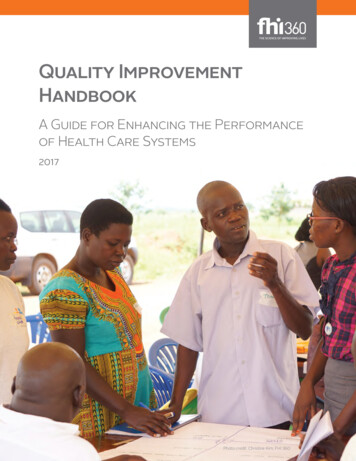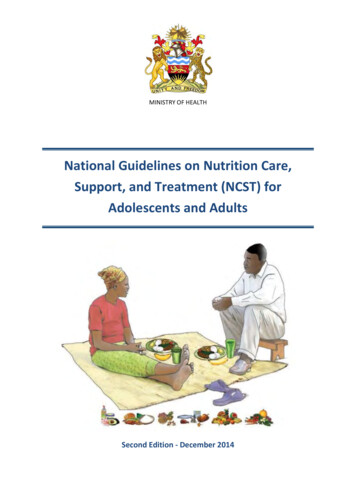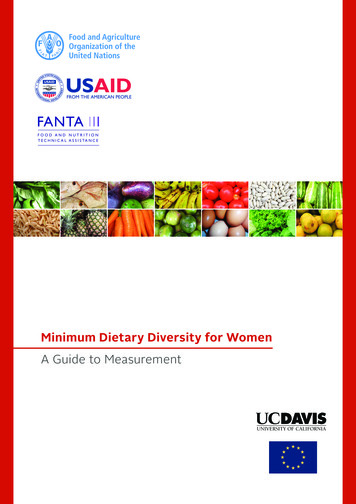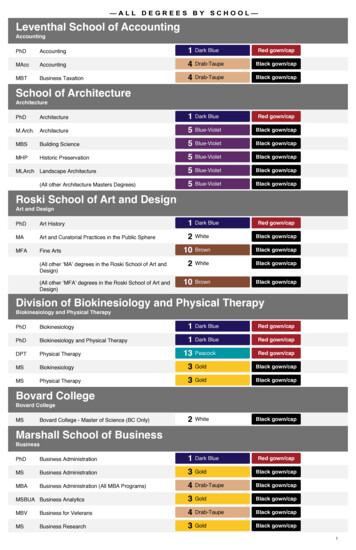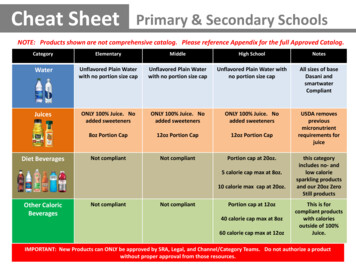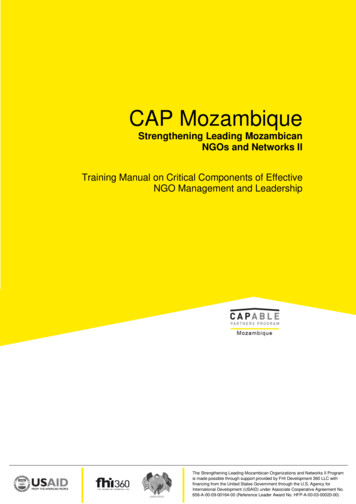
Transcription
CAP MozambiqueStrengthening Leading MozambicanNGOs and Networks IITraining Manual on Critical Components of EffectiveNGO Management and LeadershipThe Strengthening Leading Mozambican Organizations and Networks II Programis made possible through support provided by FHI Development 360 LLC withfinancing from the United States Government through the U.S. Agency forInternational Development (USAID) under Associate Cooperative Agreement No.656-A-00-09-00164-00 (Reference Leader Award No. HFP-A-00-03-00020-00)
Developed by:Dr Chiku MalungaCADECOP.O Box 1884BlantyreMalawiTel: 265 1 915 723Cell: 265 8 868624e-mail: cadeco@sdnp.org.mwWith the support of CAP Mozambique funded by USAID (United States Agencyfor International Development) with funds from President s EmergencyProgram for AIDS Relief (PEPFAR)Strengthening Leading Mozambican NGOs and Networks IITraining Manual on Critical Components of Effective NGO Management and LeadershipPage 1 of 44
OVERVIEW OF GOVERNANCE, LEADERSHIP AND MANAGEMENTExercise 1: Trends in NGO governance and leadership1. What are your observations about the issues of governance and leadership inthe world, Africa and Mozambique in the last 5 years?2. Why is there a growing interest in issues of governance and leadership andwhy now?3. How well are efforts aimed at improving governance and leadership matchingimprovement in actual practice? Why or why not?Handout 1: Trends in NGO governance and leadershipTrends shaping governance, leadership and management in Africa and beyondinclude:1. Enjoying public trust to having to be accountable2. Seeking friends to finding professional colleagues3. Large boards to right sized boards to ensure effectiveness4. Clearly separating the roles and responsibilities of the board, leadership andmanagement5. Recruiting names to recruiting valuable skills6. Orienting board and management members informally to conducting formalorientation7. From accepting to become board members while being unclear about roles andresponsibilities to committing to performance and accountability for results8. From working without performance appraisals for managers to ensuring allmanagers, officers and staff are regularly appraised and that the appraisalresults are consciously used to improve the effectiveness of the organization9. From boards holding meetings on trivial issues to strategic meetings andclearly discussing what should be discussed at board and management levels10. From need for frequent meetings to less meetings because of other improvedmeans of communication11. From a board working as one entity to boards being divided into subcommittees with different tasks to ensure participation by everyoneStrengthening Leading Mozambican NGOs and Networks IITraining Manual on Critical Components of Effective NGO Management and LeadershipPage 2 of 44
12. Financial understanding by the treasurer only to the entire board havingknowledge and ability to interpret financial information13. From ignorance to being aware of the legal implications of being boardmembers14. Serving for life and having to respect term limits especially for the board15. From boards not being involved in fundraising to being actively involvedthrough own contributions or using other means like influence or the boardand management complementing each other in fundraising or financialsustainability efforts16. Not evaluating the director to structured appraisal of the director’sperformanceExercise 2: Reflecting on trends in NGO governance and leadership1. How do the trends presented compare with practice in our partnerorganizations?2. What are the key challenges for use as capacity building service providers inhelping our partners to ensure that their governance and leadership are current?Exercise 3: Understanding governance, leadership and management1. What is your understanding of the term: governance, leadership and management?2. In an NGO, who is responsible for governance, leadership and management?Handout 2: An overview of governance, leadership and managementEvery organization has 3 functions. These are governance, leadership andmanagement. Governance is the work of the board. Management is the work of staff.In very simple terms governance means authority and accountability. Managementmeans making good use of resources. Leadership means giving direction and inspiringpeople to follow the direction to an agreed and desired destination. It is only when the3 components are functioning well simultaneously that can have an effectiveorganization.Governance has 4 main responsibilities. These are: Being custodians of the organization’s vision, mission and valuesFinancial oversightPerformance monitoring and;Ensuring financial and organizational sustainabilityManagement has 3 main responsibilities. These are; Translating the vision and mission into work and resultsStrengthening Leading Mozambican NGOs and Networks IITraining Manual on Critical Components of Effective NGO Management and LeadershipPage 3 of 44
Establishing the structure needed to make the work possibleEstablishing policies, systems and proceduresLeadership has 2 functions. These are: Formulation and communicating the vision, mission and values Inspiring and motivating people to work together in realizing the vision andaccomplishing the mission – this involves team building and team work.A significant component of organization development is building the effectiveness ofthe organization’s governance, management and leadership processes, functions andstructures. Governance development involves among other things assessing theeffectiveness of the board against the key responsibilities above and finding ways ofbridging identified gaps. Management development involves building skills andcompetences in the establishment and implementation of the key managementresponsibilities.Leadership development involves developing an individual’s or a group’s capacity tolead – critical components include developing the individual or group’s ambition,competence and integrity. In practical terms this means developing the individual orgroup capacity for visioning, learning and developing character.Hand out 3: Governance/leadership and managementGovernance of a non profit organization is the sum total of authority over andaccountability for the organization. The governance or board authority comes from itsregistration under the NGO act. The accountability to the public comes through thesame Act’s reporting and other requirements. An NGO’s constitution should clarifythe specific authority of the board. It should also articulate clearly how accountabilityis to be achieved. The constitution should make very clear who is ultimatelyresponsible for the organization’s performance and behavior.Management exercises its authority on behalf and as directed by the board, but not inits own right.Leadership is the shared responsibility of the board and management. This is always agrey area that needs continuous negotiation to avoid conflicts between the board andmanagement.The key functions of the governance, leadership and management tasks are presentedin the table below:The GovernanceThe Leadership TaskCustodians of the long Establishandterm visioncommunicate the longterm visionCustodians of the mission Formulate the mission andand strategystrategyThe Management TaskRelate the long term visionto current activitiesTranslate the mission andstrategy into achievableobjectivesStrengthening Leading Mozambican NGOs and Networks IITraining Manual on Critical Components of Effective NGO Management and LeadershipPage 4 of 44
Appoint suitable peopleInspireandmotivate Ensure people can do whatpeople to use their is expected of themcreativityEnsurethatthe Lead by exampleDevelop staff throughorganization is adequatelytraining, briefing and teamstaffedworkIdentifymajor Create more effective Establish procedures andperformance problemssystemsensure staff know how touse themFocus on long termoverview – going in theright directionMonitorsignificantchanges in the externalenvironmentFocus on effectiveness – Focus on efficiency –doing the right thingsdoing things right atminimum costLook to the future and Look at the present andcreate new opportunitiestake advantage of currentopportunities. Reactivelyappropriatelytothechallenges.Summary handoutThe Ten Basic Roles and Responsibilities of an NGO boards1. Being custodians of the organization’s vision and mission2. Hire and fire the Executive Director and other senior staff3. Assess the performance of the Executive Director4. Ensure the organization has an effective strategic plan5. Ensure the organization has adequate resources6. Ensure the organization is managing its resources effectively and efficiently7. Monitor overall organizational performance in relation to the strategic plan8. Enhance the organization’s public image9. Ensure legal and ethical integrity and maintain accountability10. Recruit and orient new board members and assess board performanceThe Ten basic roles and responsibilities of non – profit management1. Relate the long term vision to current activities on the ground2.Translate the mission and strategy into achievable objectives and projectsStrengthening Leading Mozambican NGOs and Networks IITraining Manual on Critical Components of Effective NGO Management and LeadershipPage 5 of 44
3. Ensure people can do what is expected of them by providing the neededresources and creating an enabling environment4. Identifying those parts of the people’s traditions, history and culture that canbe used as management building blocks; that is to plant imported managementconcepts in their own cultural soil and make them grow5. Seek improvements through training, briefing and team work to enable staffand volunteers grow and develop as needs and opportunities change.Management’s role is to ensure that training and development never stop inthe organization.6. Establish procedures and ensure that staff know how to use them7. Coordination of individual and group efforts for synergy8. Focus on efficiency and economy – doing things right at minimum cost9. Assess performance of staff and volunteers and use performance results toimprove organizational performance. Ensure that the staff and volunteers areresults oriented10. Look at the present and take advantage of current opportunities and reactappropriately to the challenges.The basic roles and responsibilities on non profit leadership1. Defining the organizational mission – the leadership function clarifies the purpose,aims and objectives of this organization. Why the organization’s work worthwhile.By doing this leadership establishes the long term vision and formulates the mission.2. Planning - how are we going to get from where we are now to where we want tobe? Leadership looks to the future and create new opportunities. They formulate theorganization’s strategy.3. Communication - leadership communicates, to get across to people the mission andthe plan. The most important work of leadership is to communicate the organization’svision and mission as clearly as possible.4. Making sure that all resources and energies are properly harnessed. The ultimatetask of leadership is to unleash human energies and the human spirit and vision.5. Creating more effective systems and focusing on effectiveness – doing the rightthings6.Supporting - setting and maintaining organizational and team values and standards.A key responsibility of leadership is to earn trust of the followers by demonstratingintegrity where words and actions match.7. Inspire people to use their creativity.Strengthening Leading Mozambican NGOs and Networks IITraining Manual on Critical Components of Effective NGO Management and LeadershipPage 6 of 44
8. Informing - bringing information to the organization and from the organization (toand from the board and secretariat)9. Reviewing - establishing and applying the success criteria appropriate to the fieldExercise 4: Assessment of the practice of governance, leadership and management inpartner organizations1. What is our assessment of how generally governance, leadership andmanagement are practiced among our partner organization?2. What are the key helping and hindering factors in the practice of governance,leadership and management among the partners?Exercise 5: Who does whatListed below are responsibilities typically carried out in most nonprofit organizations.If the responsibility is carried out primarily be the board, indicate that by writing‘board’ in the space provided. If the responsibility is carried out primarily by the staff,indicate that by writing ‘staff’ in the space provided. If the responsibility is carried outby both the board and the staff, indicate that by writing ‘both’ in the space provided.--------------- Hires, supports and evaluates the director--------------- Develops and implements programs--------------- Makes a personal, financial contribution to the organization--------------- Prepares for board meetings--------------- Develops and proposes policy questions about undertaking newprograms--------------- Identifies, recruits, orients, and involves new board members-------------- Ensures adequate financial controls are in place-------------- Creates fundraising strategies-------------- Develops and monitors adherence to personnel policies--------------- Approves the annual budget reflecting the organization’s goals andpolicies--------------- Promotes the organization in the communityStrengthening Leading Mozambican NGOs and Networks IITraining Manual on Critical Components of Effective NGO Management and LeadershipPage 7 of 44
-------------- Reviews the organization’s policies, procedures and by-laws------------- Develops a strategic plan and monitors the organization’s initiativesagainst it------------- Determines the organization’s vision and mission------------- Monitors income and expenses on a daily basis------------- Serves as a liaison and provides information to board committeesHandout 5: Stages of Organization Development and their Leadership andGovernance RequirementsOrganizations like living organisms are born and pass through 3 key distinct stages orphases of growth. This exercise helps participant identify the stage at which thereorganization is: pioneer/dependent phase, independent phase and interdependentphase.Pioneer PhaseCharacteristics of the pioneer phase include: Strong vision and valuesInformal and flexibleNo proceduresClose relationshipsMore of a familyIdentity bound with leaderOperates from a small roomValues are personalizedRecognition comes through friendship and mutual understandingThe crisis that drives the organization into the next phase may come as a result of thefollowing among other things: Pioneer retires/dies or can not cope with expanding organizationNeed for structures and systems to cope with growthStaff no longer content to just followIndependent phaseCharacteristics of the independent phase include: Formal structures and systems in placeTop down, strong at the topStrengthening Leading Mozambican NGOs and Networks IITraining Manual on Critical Components of Effective NGO Management and LeadershipPage 8 of 44
Minimal interaction, communication on paperAuthoritative and inflexibleMore technicalWeak at bottomStaff valued for specific contributionLoss of close relationship recognition comes from qualificationThe crisis that drives the organization into the next phase may come as a result of thefollowing among other things: Standardization leads to isolation and alienationDivision of labor leads to loss of learning, creativity and lack of flexibility.Structures and procedures ruleDepartments become separate autonomous and separated from the wholeInterdependent phase/integratedCharacteristics of the independent phase include: User friendlyFlexible and respectfulCreativity encouragedMarket purpose orientedWork as a teamShared leadership throughout organizationHuman and effectiveRecognition comes from performanceLeadership requirements of the phasesIn the pioneer phase leadership through direction giving and team building is usuallystrong. In this phase management is usually weak as informal structures and systemssuffice the ‘management needs’ of the organization. The board may play a moredirective role to organizations in this phase.In the independent phase, the establishment of structures, policies, systems andprocedures and the ensuing bureaucracy that these may bring, often suffocateleadership. The organization may become, present, inward and not future and outwardoriented. Team spirit and team work often wither away. Usually there are ‘turf’tensions between the board and management at this stage of organizationdevelopment.In the interdependent phase, the organization becomes ‘conscious’ of the need for ahealthy balance between leadership and management. Because many organizationsfail to get this consciousness, they rarely reach this phase of effectiveness. There isStrengthening Leading Mozambican NGOs and Networks IITraining Manual on Critical Components of Effective NGO Management and LeadershipPage 9 of 44
usually a healthy relationship between the board and management at this stage ofdevelopment.Exercise 6: Stages of organizational development1. At what stage of development are most of our partner organizations? How dowe know?2. What are the critical issues they need to address in order to move to the nextstage?3. How well equipped are we to help them address those issues? Whatcompetences, skills and attitudes do we need to develop so that we can helpthem better?GOVERNANCEExercise 1: Dialogue about governance1. Why do NGOs need boards?2. What does governance mean?3. What are the legal requirements for boards?4. What is the functional purpose of boards?5. Does the board have a symbolic value? If yes, what is it?Handout 6: The board development processSelection, Orientation and appraisal of board membersThe board is supposed to develop and become more effective with time. To ensurethis, the following process is necessary.AssessmentThe assessment answers the questions: What do we have and what are we missing(skills) and how are we how are we doing as a board?Who do we need?Before you think of whom to put on the board, starting thinking of where theorganization is. Do not just choose people because they have big names, it isimportant to assess how they fit with the mission and expertise and attributes that weneedHow do we get board members?Strengthening Leading Mozambican NGOs and Networks IITraining Manual on Critical Components of Effective NGO Management and LeadershipPage 10 of 44
The board can get new members from a numbers of sources, which might include:i. Membership (through AGM)ii. Support and referral from other organizationsiii. Current board identifies additional board membersiv. Advertisev. Interviewsvi. Director names new membersWhat do we do with new board members?New board members must be oriented at 2 levels: the full board and the individual.This is very important. It is wrong to assume that they already know because everyboard is unique.Orientation of the board of the introduction to the board manual, which includes:1.2.3.4.5.6.7.8.9.What is expected of the members (job descriptions)Minutes of the previous of the previous meetingA copy of the directors job descriptionConstitutionConflict of interest policy and other policiesOrganizational biographyPlans and brochuresBoard members profilesFunding status – history (what, how much, when, by whom)Support from the chair and mentorsWithin a stipulated period, the president of the general assembly must follow up onnew members and find out if their expectations are being met, this will determine thedevelopment activities necessary.Annual assessment for the boardThose who are successful continue and those not successful should be told to gohome. The most successful boards have annual assessment. Those continuing shouldrenew commitment. Terms of tenure must always be respected.Criteria for board selectionA criterion like the one given below can be used to identify the skills and diversity ofpeople currently available in the board but also the gaps depending on the nature ofwork the institution is carrying out. Below are the various skills (not exhaustive) thatboard members will bringCriteriaSkills in the board?NamesAccess to money and fund developmentTheology, missionsFinancial and general managementStrengthening Leading Mozambican NGOs and Networks IITraining Manual on Critical Components of Effective NGO Management and LeadershipPage 11 of 44
Community developmentHuman resourcesPlanningLegal fessionPlace of originExercise 2: How does the above process compare with our practice of boarddevelopment? Which aspects do we need to work on in order to improve our practice?Handout 7: Legal duties of board membersThe board governs the life of the organization. As a rule, this means that the boardholds ultimate power within the organization. Exception to this rule occurs when theconstitution assign ultimate responsibility for certain decisions to the organization’smembership, or in the case of a subsidiary, to the parent organization.Whether or not a board is accountable to another body, such as the membership or aparent organization, a board is always accountable to the public trust. It is responsiblefor ensuring that the organization operates within the law. It also has a moralresponsibility for safeguarding the NGO’s mission and resources in such a s way as tomaintain public trust. When the board neglects its moral and/or legal obligations, thewhole NGO sector suffers because the public trust in NGOs in general is weakened.A board member must meet certain standards of conduct and attention to his or herresponsibilities to the organization. These are referred to as: Duty of Care, Duty ofLoyalty, and the Duty of Obedience. Duty of Care: Board members must exercise due care in all dealing with theorganization and its interests. This includes careful oversight of financial matters andStrengthening Leading Mozambican NGOs and Networks IITraining Manual on Critical Components of Effective NGO Management and LeadershipPage 12 of 44
reading of minutes, attention to issues that are of concern to the organization andraising questions whenever there is something that seems unclear or questionable. Duty of loyalty: Conflict of interest, including the appearance of conflict ofinterest, must be avoided. This includes personal and professional conflicts of interestor conflict with other organizations with other organizations with which a boardmember is connected. Duty of obedience: Obedience to the organization’s central purposes must guideall decisionsExercise 3: Legal duties of board membersDuty of careBoards of our partner organizations carry out these duties by:1.2.3.Duty of loyaltyBoards of our partner organizations carry out these duties by:1.2.3.Duty of obedienceBoards of our partner organizations carry out these duties by:1.2.3.Hand out 8: Conflict of interestAn important responsibility of a board is to ensure accountability for the organization.Actions perceived to involve conflicts of interest (where personal or business benefitsrather than the NGO’s benefit are placed first) undermine public trust. Incontemplating conflict of interest, the following questions focus on specific actionsand decisions.Strengthening Leading Mozambican NGOs and Networks IITraining Manual on Critical Components of Effective NGO Management and LeadershipPage 13 of 44
Elements of conflict of interest policy DisclosureClear removal from discussion and votingMechanisms for keeping the board chair and director informedCommon dilemmas for boardsA lawyer or accountant provides services to the organization-Who will do the work?Will we be obligated to accept work of less than superior quality?Is the price competitive? Have we given others a chance to bid?A board member becomes a consultant for a project-Can the awarding of the contract be defended?Can the director adequately supervise or assess the work of the boardmember?Are lines of authority clear?Should the board member rotate off the board until the work is finished?The director of a local affiliate serves on the national board of the parent organization-Which organization does the individual represent in her board service?Are there areas which might pose a potential conflict of interest for thisboard member?Exercise 4: Conflict of interest1. What are some of the common conflicts of interest we see among our partners’boards?2. What are the main causes of these conflicts of interest?3. How have helped them address these conflicts of interest?4. How effective have efforts been, why or why not?Handout 9: How do we safeguard against conflict of interest? What is conflict of interest?When the personal or professional concerns of a board member or a staff memberaffect his or her ability to put the welfare of the organization before personal benefit, aconflict of interest exists. NGO board members are likely to be affiliated with manyorganizations in their communities, both on a professional and personal basis, so it isnot unusual for actual or potential conflict of interest to arise.Strengthening Leading Mozambican NGOs and Networks IITraining Manual on Critical Components of Effective NGO Management and LeadershipPage 14 of 44
Why must we be concerned with conflict of interest?Board service in the NGO sector carries with it important ethical obligations. NGOsserve the broad public good; when board members fail to exercise reasonable care intheir oversight of the NGO, they are not living up to their public trust. In addition,board members have a legal responsibility to assure the prudent management of anorganization’s resources. In fact, they may be held liable for the organization’sactions. A 1974 court decision in the USA known as the ‘Sibley Hospital Case’ set aprecedent by confirming that board members can be held legally liable for conflict ofinterest because it constitutes a breach of their fiduciary responsibility. Does conflict of interest only involve financial accountability?No. Conflict of interest relates broadly to ethical behavior, which includes not justlegal issues but considerations in every aspect of governance. A recent statement byIndependent Sector describes three levels of ethical behavior: (1) obeying the law, (2)decisions where the right action is clear, but one is tempted to take a different course;and (3) decisions that require a choice among competing options. The third level ofbehavior can pose especially difficult ethical dilemmas for NGO board members. What can be done to prevent conflict of interest situations?Self-monitoring is the best preventive measure. Institute a system of checks andbalances to circumvent actual or potential conflicts of interest, beginning with welldefined operating policies on all matters that might lead to conflict. Most important,create a carefully written conflict of interest policy based on the organization’s needsand circumstances. Ask each board and staff member to agree in writing to uphold thepolicy. Review the policy regularly as part of the board assessment process. What should be included in a conflict of interest policy?1. Full disclosure – board members and staff members in decision making rolesshould make known their connections with groups doing business with theorganization. This information should be provided annually.2. Board members abstention from discussing and voting – Board members whohave an actual or potential conflict of interest should not participate indiscussions or vote on matters affecting transactions between the organizationand the other group.3. Staff member abstention from decision making – staff members who have anactual or potential conflict should not be substantively involved in decisionmaking affecting such transactions What are some examples of actual and potential conflict of interest?-Organization policy requires competitive bidding on purchases of morethan 1, 000.00 but a printing firm owned by a board member’s spousereceives the 25,000.00 contract for the annual report and no other bids aresolicited.Strengthening Leading Mozambican NGOs and Networks IITraining Manual on Critical Components of Effective NGO Management and LeadershipPage 15 of 44
--A board member serves on two boards in the same community and findshimself or herself in the position of approaching the same donors on behalfof both NGOsA staff member receives an honorarium for conducting a workshop foranother group in the organization’s field of interest.Should an organization contract with a board member for professional services, suchas legal counsel or accounting?Attorneys, accountants and other professionals can contribute valuable expertise to aboard. Due to the potential for conflict of interest, their contributions should bevoluntary. At the very least, a board member who is associated with a firm competingfor a contract should abstain from discussion and voting in the selection process. If acompetitive bidding process results in the selection of that board member’s firm, he orshe should disclose the affiliation and abstain from voting on future board actionsconnected with that firm’s contract with the NGO.Hand out 10: Board Responsibility checklistAttend board meetings regularlyKeep a written, permanent record of all board minutes and official actions; and havethem reviewed by a board member who is lawyer or by retained counselExercising general supervision over the organization’s affairsInvestigate and audit the organization’s decisionsCorporate decisions require knowledge of the subject and a great deal of commonsense. If you vote in the minority, make sure your vote is so noted in the minutes.Pursue the warning signs that come to your attention that something is w
NGO Management and Leadership. The Strengthening Leading Mozambican Organizations and Networks II Program is made possible through support provided by FHI Development 360 LLC with financing from the United States Government through the U.S. Agency for International Development (USAID) under Associate Cooperative Agreement No.
